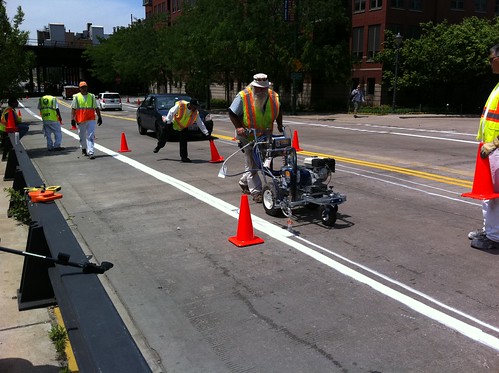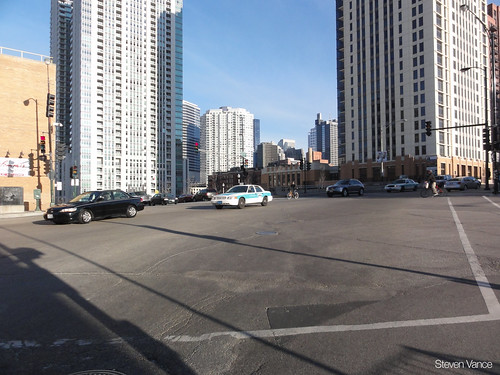Kinzie. It's what's next.
Hopefully you've heard by now that CDOT will begin construction this week on the city's first protected bike lane: Kinzie Street from Milwaukee Avenue/Desplaines Street to Wells Street.
Full story on Steven Can Plan.
I want to know what you think about this.
- What do you feel will need special attention?
- Is this the right or wrong location for such a facility? Why?
- Are you going to thank/congratulate Rahm, Gabe, and the CDOT Bicycle Program?
- Will you use it?
Cycle track and protected bike lane naysayers, this isn't the post for you. But if you've ridden in protected bike lanes before, then I welcome your constructive comments and criticism based on your actual experiences.
The new beginning. Looking southeast at the intersection of Kinzie/Milwaukee/Desplaines.
Tags:
Replies to This Discussion
-
Permalink Reply by Carter O'Brien on June 14, 2011 at 10:26am
-
A bike box... now all that's left is for the Cubs to win the Series so hell can finally freeze over. Amazing.
-
Permalink Reply by Far'arned Retrogrumpalunkus #63 on June 14, 2011 at 11:05am
-
Nice picture Steven.
I see a crew came by today and painted brand new straight white lines on Kedzie that look just like this for just the block right in front of the Logan Square Blue Line Station. No other marking as to what they are and I sure as Zeus haven't a clue. Nothing else seems to have been painted in the area as far as I could tell in my travels today.
There is parking on the Northbound side of Kedzie from Milwaukee to Emmett so maybe these lines delineates this, but on the Southbound side there is no parking although taxis always stand just north of the bus station part. Is this the beginning of a bike lane here or something else? Maybe another crew will come by later today or tomorrow and paint something else. Who knows?
Stuff is happening. I haven't seen anyone out painting new lines anywhere in ages. Nice that the city is actually going to do something with the money they take in taxes rather than lining pockets and kickbacks.
-
Permalink Reply by milesperhour on June 14, 2011 at 3:26pm
-
Carter O'Brien said:
Closely related to this is the more endemic problem of motorists using the so-called "rush hour lanes" (pure fantasy, IMO) as extra lanes of traffic. Sorry drivers, and I am one as well, but a no parking designation doesn't equate to a lane for you to drive in unless said lane has been clearly demarcated.
I'll admit, I'm guilty of this. What is the reasoning behind the no parking then?
James Baum said:
Stuff is happening. I haven't seen anyone out painting new lines anywhere in ages. Nice that the city is actually going to do something with the money they take in taxes rather than lining pockets and kickbacks.
I was thinking the same thing. They recently painted (or repainted?) shared bike lane markings on California.
-
Permalink Reply by Far'arned Retrogrumpalunkus #63 on June 14, 2011 at 3:32pm
-
In Madison the parking lanes are intended as "rush hour lanes" through the isthmus. Most notably are Johnson/Gorham where there are legions of tow trucks waiting for the hour to click over. Until they get them moved it is chaos. It makes a huge difference and improves flow dramatically. When people expect the lanes to be clear and they are not it's a mess!
-
Permalink Reply by Duppie on June 15, 2011 at 5:50am
-
Ooohhh, pretty....
Take a look a the Chicago Bike program flickr account:http://www.flickr.com/photos/chicagobikes/sets/72157626915405132/?p...
Lots of green paint, bollards everywhere (yes, on the bridge too!), sharrows.....
***does happy dance in cubicle, followed by incredible self-loathing caused by not riding in today***
-
Permalink Reply by Joel on June 15, 2011 at 5:52am
-
If they could get those bollards and some paint on all of the bridges it would be a huge help. The open grate still wouldn't be safe, but at least it would give you some room.
-
Permalink Reply by Carter O'Brien on June 15, 2011 at 6:00am
-
First, fabulous improvement on Kinzie! Don't mean to hihjack the thread, but it really is all connected, so in response to mph & James:
mph, I wouldn't necessarily assume there's solid reasoning behind anything parking or traffic-related in Chicago. There are streets all over the City that are one-way in a given direction not because of any CDOT traffic-flow study, but simply as a politician or other well-connected person was able to convince the City to make a change because they didn't like cars going down their block. Understandable from a micro perspective, disastrous from a macro one. Lake View especially seems to be full of weird one-way streets that suddenly change direction inexplicably.
Regarding why we have no parking on major arterials during rush hours if they aren't meant for traffic, I would posit it's simply because having people pulling in/out of the parking spaces blocks traffic flow. It's also a way of keeping cars from using those streets for long-term storage, and helps the buses pull over and pull out of their loading stops.
Either way, the law is spectacularly clear - it's either a lane, or it's not. Exceptions to this are always extremely vivid, such as the reversible lane signs they have up in Edgewater where LSD drive ends and splits into Sheridan and Hollywood.
Ironically, for a biker on these streets having a few cars illegally parked is a boon - it keeps the street from temporarily being converted into a 4 lane street with no markings, which of course the intersections are almost never designed for - if you're in that faux lane with the intention of going straight, at some point you will be blocking a bus stop and/or a turn lane, and the ripple effect ends up making those intersections very pedestrian-unfriendly as well.
James- I suspect Madison implemented this concept with a lot more foresight than Chicago. If they want "rush hour" lanes, the City needs to figure out where we're supposed to bike on these streets and how we're going to get the 3 feet of safe passing distance between us and the cars. Remember, you don't need a bike lane to be legally entitled to ride on the street, Chicago law requires people over 13 to be on the street, barring "no bike riding" signs such as for that strip of north Sheridan or LSD.
milesperhour said:
Carter O'Brien said:
Closely related to this is the more endemic problem of motorists using the so-called "rush hour lanes" (pure fantasy, IMO) as extra lanes of traffic. Sorry drivers, and I am one as well, but a no parking designation doesn't equate to a lane for you to drive in unless said lane has been clearly demarcated.
I'll admit, I'm guilty of this. What is the reasoning behind the no parking then?
James Baum said:
Stuff is happening. I haven't seen anyone out painting new lines anywhere in ages. Nice that the city is actually going to do something with the money they take in taxes rather than lining pockets and kickbacks.
I was thinking the same thing. They recently painted (or repainted?) shared bike lane markings on California.
-
Permalink Reply by Steven Vance on June 15, 2011 at 6:08am
-
Totally.
Joel said:
If they could get those bollards and some paint on all of the bridges it would be a huge help. The open grate still wouldn't be safe, but at least it would give you some room.
-
Permalink Reply by Anne Alt on June 15, 2011 at 6:49am
-
I like this idea.
Joel said:
If they could get those bollards and some paint on all of the bridges it would be a huge help. The open grate still wouldn't be safe, but at least it would give you some room.
-
Permalink Reply by Michelle S on June 15, 2011 at 7:31am
-
So for those of us unfamiliar with "soft hit bollards," how soft are they exactly? What happens if a cyclist hits one? They look pretty scary and rigid to me on those pictures.
-
Permalink Reply by chixieonfixie on June 15, 2011 at 1:30pm
-
Is that an oversized Gandalf with the paint machine in the center?
Steven Vance said:
Take a look at Day 7 construction on Kinzie Street
- Continued work on eastbound/westbound portions.
- Also painted a bike box and left turn lane green (Milwaukee/Desplaines).

-
Permalink Reply by Far'arned Retrogrumpalunkus #63 on June 15, 2011 at 1:32pm
Groups
-
Chicagoland Beer Explora…
203 members
-
Wednesday Night for Mort…
1 member
-
Great Lakes Ultra Cycling
270 members
-
Major Taylor Internation…
1 member
-
Critical Mass discussion
261 members
